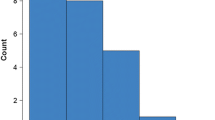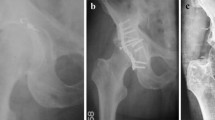Abstract
Purpose
Our purpose was to assess functional outcomes, radiographic characteristics and complications in patients who underwent fixation of acetabular fracture using percutaneous means only.
Methods
This was a retrospective cohort study of adult patients with an acetabular fracture admitted to a level 1 trauma centre and treated with closed reduction and percutaneous fixation. Nineteen patients were identified, and mechanism of injury, radiologic classification of fracture, complications and functional outcomes were analysed. Outcome measurements included Patient Reported Outcomes Measurement Information System (PROMIS) and Western Ontario and McMaster Universities Osteoarthritis Index (WOMAC) scores, which are validated patient questionnaires assessing functional outcome. They are scored as a point range on a per-question basis, with a combined range possibility of 0–96 for WOMAC and 5–75 for PROMIS.
Results
Nineteen patients over a two year period were reviewed. Fracture displacement improved following surgery from a mean 7.3 mm (range 0–33 mm) to 2.6 mm (range 0–12 mm). Complications included one post-operative death from non-ST-segment elevation myocardial infarction, sciatic nerve injury, malpositioned screw and deep infection. There were no vascular injuries, pulmonary emboli or deep venous thromboses. Of the 19 patients eligible for the study, seven completed both PROMIS mobility and WOMAC osteoarthritis questionnaires at a mean follow-up of 572 days (1.57 years), with a range of 435–862 days. The average WOMAC score was 7.4 (range 0–30) and mean PROMIS score 66.4 (range 50–75).
Conclusions
Functional outcomes in this study are comparable with other published studies and support percutaneous management of acetabular fractures as an effective alternative to open reduction and internal fixation.




Similar content being viewed by others
References
Judet R, Judet J, Lanzetta A, Letournel E (1968) Fractures of the acetabulum: classification and guiding rules for open reduction. Arch Orthop 81(3):119–158
Stover M, Weresh MJ, Bosse MJ et al (2000) Nonoperative treatment of fractures of the acetabulum. Abstr: Orthop Trauma Assoc 14:148–149
Tile M, Olson SA (2003) Decision making: Nonoperative and operative indications for acetabular fractures. In: Tile M, Helfet DL, Kellam JF (eds) Fractures of the Pelvis and Acetabulum, 3rd edn. Lippincott Williams & Wilkins, Philadelphia, pp 496–532
Gay SB, Sistrom C, Wang GJ et al (1992) Percutaneous screw fixation of acetabular fractures with CT guidance: preliminary results of a new technique. AJR Am J Roentgenol 158(4):819–822
Kim JW et al (2015) Acetabular fractures in elderly patients: a comparative study of low-energy versus high-energy injuries. Int Orthop 39:1175–1179
Bozzio AE, Wydra FB, Mitchell JJ, Ackerson RM, Mauffrey CM (2014) Percutaneous fixation of anterior and posterior column acetabular fractures. Orthopedics 37(10):675–678
Dienstknecht T et al (2013) Screw placement in percutaneous acetabular surgery: gender differences of anatomical landmarks in a cadaveric study. Int Orthop 37(4):673–679
Bellamy N (1982) Osteoarthritis — an evaluative index for clinical trials. MSc thesis, McMaster University
Cella D, Riley W, Stone A et al (2010) The Patient Reported Outcome Measurment Information System (PROMIS) developed and tested its first wave of adult self-reported health outcome item banks: 2005–2008. J Clin Epidemiol 63:1179–1194
Fica G et al (1998) Open reduction and internal fixation of acetabular fractures. Int Orthop 22(6):348–351
Gary JL, VanHal M, Gibbons SD et al (2012) Functional outcomes in elderly patients with acetabular fractures treated with minimally invasive reduction and percutaneous fixation. J Orthop Trauma 26(5):278–283
Starr AJ, Jones AL, Reinert CM et al (2001) Preliminary results and complications following limited open reduction and percutaneous screw fixation of displaced fractures of the acetabulum. Injury 32(suppl 1):45–50
Kazemi N, Archdeacon MT (2012) Immediate full weightbearing after percutaneous fixation of anterior column acetabulum fractures. J Orthop Trauma 26(2):73–79
Oberst M, Hauschild O, Konstantinidis L, Suedkamp NP, Schmal H (2012) Effects of three-dimensional navigation on intraoperative management and early postoperative outcome after open reduction and internal fixation of displaced acetabular fractures. J Trauma Acute Care Surg 73(4):950–956
Conflicts of interest
None
Author information
Authors and Affiliations
Corresponding author
Rights and permissions
About this article
Cite this article
Bozzio, A.E., Johnson, C.R. & Mauffrey, C. Short-term results of percutaneous treatment of acetabular fractures: functional outcomes, radiographic assessment and complications. International Orthopaedics (SICOT) 40, 1703–1708 (2016). https://doi.org/10.1007/s00264-015-2987-0
Received:
Accepted:
Published:
Issue Date:
DOI: https://doi.org/10.1007/s00264-015-2987-0




